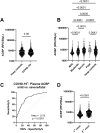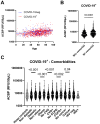Extracellular acyl-CoA-binding protein as an independent biomarker of COVID-19 disease severity
- PMID: 39835130
- PMCID: PMC11743960
- DOI: 10.3389/fimmu.2024.1505752
Extracellular acyl-CoA-binding protein as an independent biomarker of COVID-19 disease severity
Abstract
Background: Factors leading to severe COVID-19 remain partially known. New biomarkers predicting COVID-19 severity that are also causally involved in disease pathogenesis could improve patient management and contribute to the development of innovative therapies. Autophagy, a cytosolic structure degradation pathway is involved in the maintenance of cellular homeostasis, degradation of intracellular pathogens and generation of energy for immune responses. Acyl-CoA binding protein (ACBP) is a key regulator of autophagy in the context of diabetes, obesity and anorexia. The objective of our work was to assess whether circulating ACBP levels are associated with COVID-19 severity, using proteomics data from the plasma of 903 COVID-19 patients.
Methods: Somalogic proteomic analysis was used to detect 5000 proteins in plasma samples collected between March 2020 and August 2021 from hospitalized participants in the province of Quebec, Canada. Plasma samples from 903 COVID-19 patients collected during their admission during acute phase of COVID-19 and 295 hospitalized controls were assessed leading to 1198 interpretable proteomic profiles. Levels of anti-SARS-CoV-2 IgG were measured by ELISA and a cell-binding assay.
Results: The median age of the participants was 59 years, 46% were female, 65% had comorbidities. Plasma ACBP levels correlated with COVID-19 severity, in association with inflammation and anti-SARS-CoV-2 antibody levels, independently of sex or the presence of comorbidities. Samples collected during the second COVID-19 wave in Quebec had higher levels of plasma ACBP than during the first wave. Plasma ACBP levels were negatively correlated with biomarkers of T and NK cell responses interferon-γ, tumor necrosis factor-α and interleukin-21, independently of age, sex, and severity.
Conclusions: Circulating ACBP levels can be considered a biomarker of COVID-19 severity linked to inflammation. The contribution of extracellular ACBP to immunometabolic responses during viral infection should be further studied.
Keywords: Acyl-CoA-binding protein; BQC-19 biobank; COVID-19; SARS-CoV-2; autophagy; proteomics.
Copyright © 2025 Isnard, Mabanga, Royston, Berini, Bu, Aiyana, Feng, Lebouché, Costiniuk, Cox, Kroemer, Durand, Routy and the Biobanque Québécoise de la COVID-19 (BQC-19).
Conflict of interest statement
GK has been holding research contracts with Daiichi Sankyo, Eleor, Kaleido, Lytix Pharma, PharmaMar, Osasuna Therapeutics, Samsara Therapeutics, Sanofi, Sutro, Tollys, and Vascage. GK is on the Board of Directors of the Bristol Myers Squibb Foundation France. GK is a scientific co-founder of everImmune, Osasuna Therapeutics, Samsara Therapeutics and Therafast Bio. GK is in the scientific advisory boards of Hevolution, Institut Servier, Longevity Vision Funds and Rejuveron Life Sciences. GK is the inventor of patents covering therapeutic targeting of aging, cancer, cystic fibrosis and metabolic disorders. GK’s brother, Romano Kroemer, was an employee of Sanofi and now consults for Boehringer-Ingelheim. GK’s wife, Laurence Zitvogel, has held research contracts with Glaxo Smyth Kline, Incyte, Lytix, Kaleido, Innovate Pharma, Daiichi Sankyo, Pilege, Merus, Transgene, 9 m, Tusk and Roche, was on the on the Board of Directors of Transgene, is a cofounder of everImmune, and holds patents covering the treatment of cancer and the therapeutic manipulation of the microbiota. BL has received consultancy fees and/or honoraria and research funds from Gilead, ViiV Healthcare, and Merck all outside of the scope of this work. The remaining authors declare that the research was conducted in the absence of any commercial or financial relationships that could be construed as a potential conflict of interest. The author(s) declared that they were an editorial board member of Frontiers, at the time of submission. This had no impact on the peer review process and the final decision.
Figures


References
-
- Sweet D, Freeman M, Zidar D. Immunohematologic Biomarkers in COVID-19: Insights into Pathogenesis, Prognosis, and Prevention Vol. 8. PAI; (2023). Available at: https://www.paijournal.com/index.php/paijournal/article/view/572. - PMC - PubMed
MeSH terms
Substances
LinkOut - more resources
Full Text Sources
Medical
Miscellaneous

